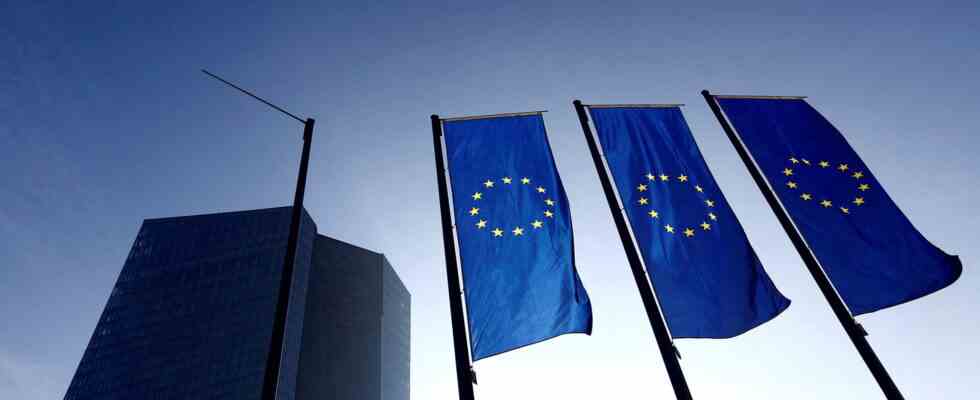Status: 08.06.2022 6:30 p.m
Tomorrow the European Central Bank is expected to announce the end of its loose monetary policy. But what does that mean for consumers – for example in the case of building interest?
These are not easy times for real estate buyers: Since the beginning of the year, interest rates on building loans have risen by almost 300 percent. This means that with a fixed interest rate of ten years, consumers now have to pay around three percent. In December 2021, interest rates were still around 0.9 percent.
“For a loan of over 400,000 euros, which is to be repaid at the beginning with three percent, that’s 2,000 euros in interest payments per month. Nine months ago, the interest payments were still around 1,300 euros,” Finanztip editor-in-chief Hermann-Josef Tenhagen calculates the effects of the jump in interest rates.
Interest rates are rising as a result of high inflation
The reason for the extremely high interest rates is the high inflation. As a result of the energy crisis in April, it rose to more than eight percent in the euro zone – and is now also reflected in lending rates. Because the banks expect due to the high prices that there could be defaults in loan repayments. In order to compensate for this risk financially, interest rates for consumers are already rising.
Bund yield at eight-year high
But it’s not just consumer interest rates that are rising. The state has also had to pay interest on borrowed money for the first time in almost eight years. Because the yield on the ten-year federal bond has climbed back above the 1.0 percent mark. The state is now paying extra to finance state spending, such as infrastructure projects, armaments and social spending.
If the yields on federal bonds now rise, this has a direct impact on the development of construction interest rates: Because banks mostly deny their construction financing business through trading in mortgage bonds. The Pfandbrief interest rates are set according to the specifications of DekaBank Deutsche Girozentrale in Frankfurt. And when determining the return on the Pfandbriefe, DekaBank bases its calculations on the interest rates on ten-year government bonds.
How does a federal bond work?
A federal bond is used for state financing. Institutional investors lend their capital to the federal government for a certain period of time. In return, they receive fixed interest (coupon). Private investors also have the opportunity to buy or sell shares in federal bonds via the stock exchange.
The USA is a role model for the turnaround in interest rates
This development is likely to continue for the time being. The European Central Bank in Frankfurt could announce an initial increase in key interest rates as early as tomorrow – but it is more likely that it will pave the way for the first key interest rate hike in July, which is likely to be followed by others.
With the turnaround in interest rates, the ECB will follow the example of the US Federal Reserve with a time lag. It has already raised key interest rates in the US twice this year, even by half a percentage point at the beginning of May. This development is already reflected in the yields on American government bonds, explains Arthur Brunner, bond specialist at ICF Bank: “In the USA, the yields on 10-year government bonds are already around three percent.”
Tenhagen is of the opinion that the ECB should not implement the turnaround in interest rates in Europe quite so drastically. Historical developments have shown that the ECB is acting more cautiously, while the Fed is more aggressive in monetary policy – also due to its task of keeping the US economy running. “Interest rates are rising faster in the USA, but they are also falling faster than in the euro zone,” said Tenhagen.
Are savings rates going up now?
And yet: If the European Central Bank raises the key interest rate, even if only in small steps, the effects will be noticeable for all Europeans. For savers, the announced turnaround in interest rates sounds good at first: After years, there could finally be interest again on overnight and time deposit accounts. But the calculation is not that simple, explains Tenhagen in an interview tagesschau.de: “As long as inflation exceeds interest rates, rising interest rates will be eaten up by inflation.” For savers, the current situation is still a negative business – despite almost 1.5 percent interest on the fixed-term deposit account.
Homeowners, on the other hand, could now ward off rising interest rates in the coming years by rescheduling, says Tenhagen: “If I have a loan that expires in two to three years, then it can still be worth rescheduling now, because interest rates will probably continue climb.” Builders could still benefit from the interest rates, which are still very low by historical standards.
How the development in the euro zone will continue depends to a large extent on the decisions of the central bank. The ECB had already indicated that it would raise interest rates for the first time in July. The next rate hikes could then follow in September or December.
Bond market – how much will interest rates rise?
Lilli-Marie Hiltscher, HR, 06/08/2022 4:59 p.m

